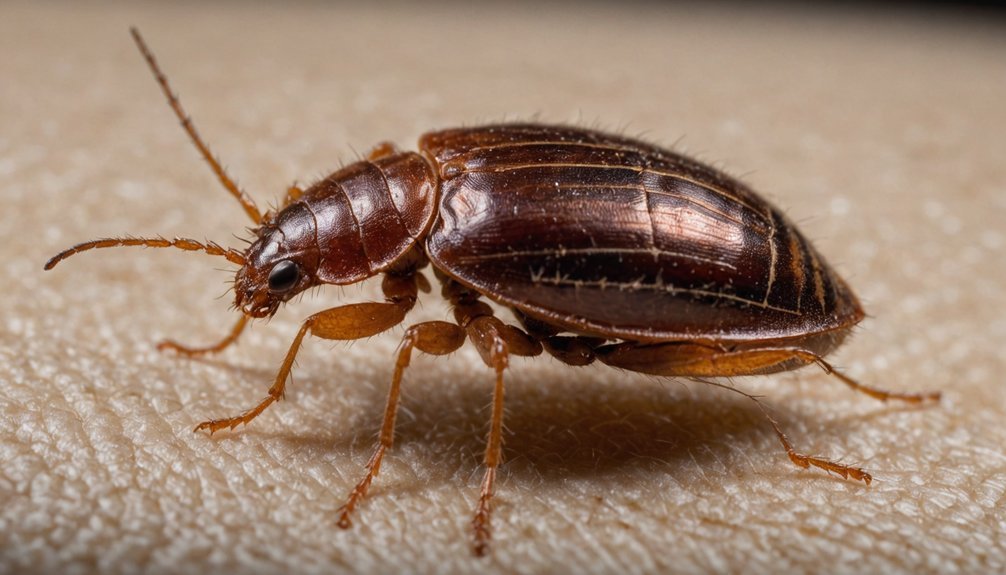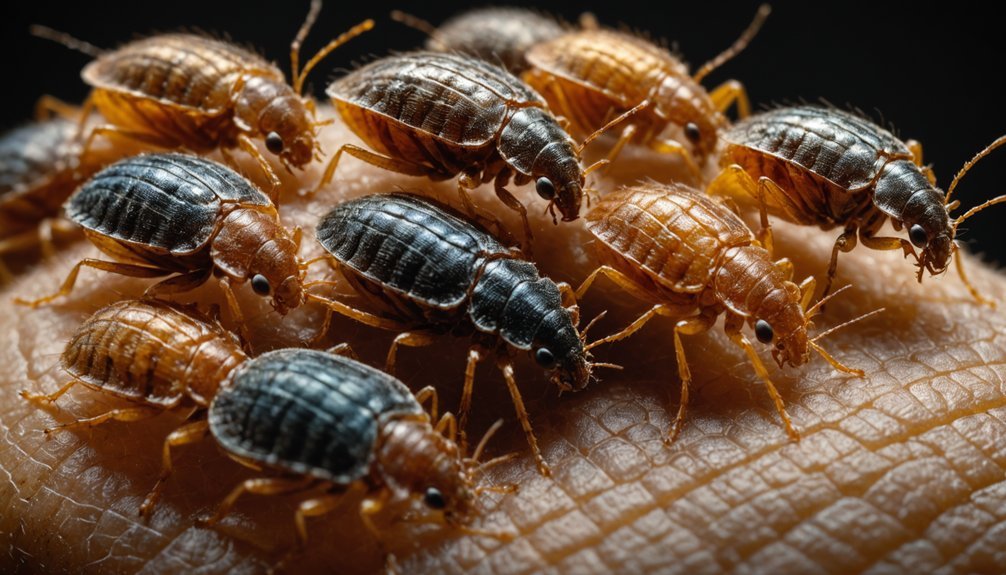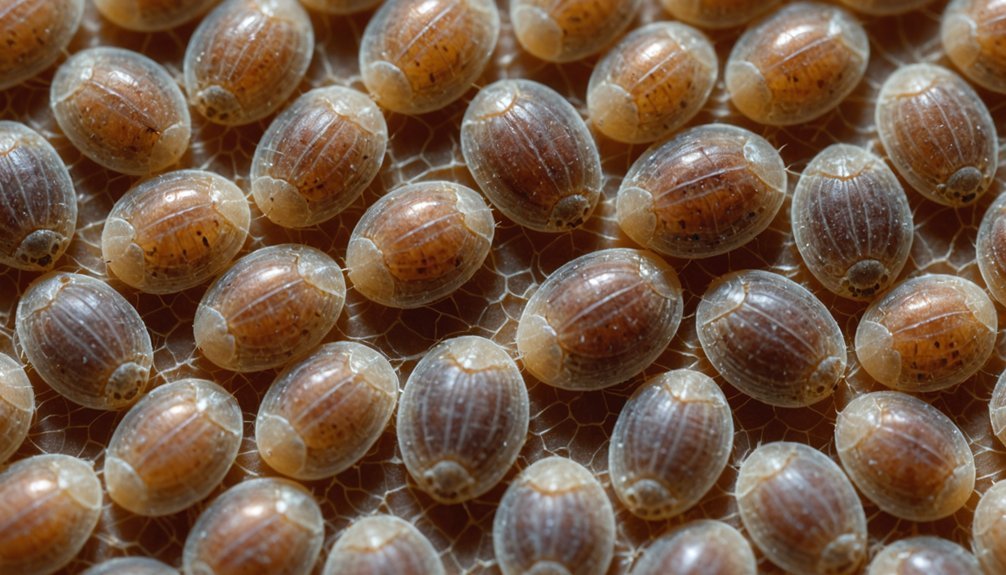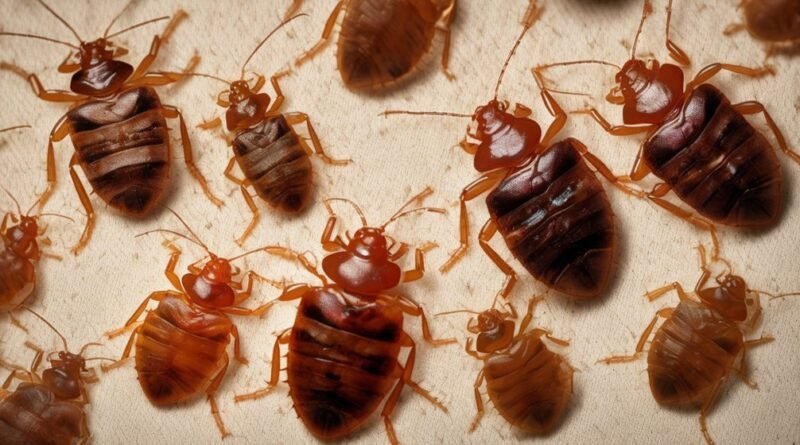What Do Bed Bugs Look Like? Pictures & Key Differences
You’ll want to identify bed bugs quickly if you suspect they’ve invaded your home. These apple seed-sized pests can hide in the tiniest cracks, making detection challenging until an infestation grows. While several household insects might resemble bed bugs at first glance, knowing the exact features of these bloodsucking parasites can save you time, money, and unnecessary worry. Let’s examine the telltale signs that set bed bugs apart from their lookalikes.
Key Takeaways
- Adult bed bugs are reddish-brown, apple seed-sized insects measuring 4-7mm with flat oval-shaped bodies and fine golden hairs.
- After feeding, bed bugs become darker red and their bodies expand noticeably from their normally flat appearance.
- Young bed bugs (nymphs) start nearly transparent at 1.5mm and grow through five stages until reaching adult size.
- Bed bugs leave distinct evidence including dark fecal spots, bloodstains on sheets, and shed exoskeletons near nesting areas.
- Unlike fleas or ticks, bed bugs have six legs, cannot jump or fly, and don’t remain attached to hosts.
Adult Bed Bug Appearance and Size Reference

Three key features distinguish adult bed bugs: their apple seed-like size ranging from 4 to 7 millimeters, their flat oval-shaped bodies, and their reddish-brown coloring.
You’ll notice these insects are relatively small but visible to the naked eye, measuring about 1.5 to 2 millimeters in width. Their appearance changes dramatically after feeding – their normally flat bodies become swollen and elongated, while their color deepens to a darker red. Being skilled at hiding, these pests are most active at night when humans are sleeping.
Adult bed bugs expand noticeably after feeding, transforming from flat to swollen as their bodies fill with blood.
If you look closely, you’ll spot fine golden hairs covering their bodies, though you might need magnification to see them clearly.
While they can’t fly, they’re surprisingly mobile, able to crawl at speeds up to 7.6 feet per minute.
Don’t confuse them with similar-looking insects – bed bugs have distinctive wing pads and a musty-sweet odor when crushed.
Nymph Stages and Growth Development

A bed bug’s life cycle includes five distinct nymph stages, known as instars, before reaching adulthood. You’ll notice these immature bed bugs start nearly transparent at 1.5mm and gradually develop into reddish-brown specimens reaching 4.5mm. Each stage requires a blood meal to trigger molting and growth to the next phase. Each female can lay 500 eggs throughout her reproductive lifetime, perpetuating the cycle of infestation.
| Stage | Size | Color |
|---|---|---|
| 1st Instar | 1.5mm | Clear/Translucent |
| 2nd Instar | 2.0mm | Light Yellow/Tan |
| 3rd Instar | 2.5mm | Yellow/Tan |
| 4th Instar | 3.0mm | Tan/Light Brown |
| 5th Instar | 4.5mm | Reddish-Brown |
Under ideal conditions (70°F+), nymphs can complete their development in 2-6 weeks. Without regular blood meals, they’ll become dehydrated and die within days. While early instars are vulnerable and less mobile, later stages become more resilient and better at hiding.
Egg Characteristics and Where to Find Them

Before bed bugs develop into nymphs, they start as minuscule eggs measuring just 1mm in length – about the size of a pinhead. These pearl-white or translucent eggs develop a dark eye spot if they’re more than 5 days old.
You’ll find them cemented to surfaces in small clusters, appearing like tiny white grains. Under optimal conditions, these eggs will hatch in 6-10 days.
Female bed bugs typically lay their eggs in areas close to where people sleep. Check mattress seams, bedding folds, furniture crevices, behind baseboards, and inside electrical outlets.
While they’re difficult to spot without magnification due to their size, you can confirm an infestation by finding these sticky eggs alongside shed skins and dark fecal spots.
To eliminate eggs, wash bedding in hot water (120°F+), vacuum thoroughly, and consider professional treatments, as many insecticides don’t target eggs effectively.
Common Lookalike Insects to Watch For
Many household insects can be mistaken for bed bugs, leading to unnecessary panic and costly treatments.
Fleas are smaller, more oval-shaped, and can jump, while bed bugs only crawl. Ticks have eight distinctive legs and remain attached to their hosts for extended periods.
While both pests cause concern, fleas can be identified by their jumping ability, unlike bed bugs that strictly crawl.
Cockroach nymphs have visible antennae and a shinier exterior, typically staying in kitchens and bathrooms.
Bat bugs and swallow bugs look nearly identical to bed bugs but mainly infest areas where their namesake hosts live.
Spider beetles have longer legs and antennae, creating a distinctive spider-like appearance. They’re often found in pantries and baseboards.
Carpet beetles and their larvae might also cause confusion – the adults are oval-shaped and dark, while their hairy larvae can trigger skin reactions similar to bug bites. Unlike bed bugs, they feed on natural fibers rather than blood.
Physical Signs of Bed Bug Activity
Identifying bed bugs requires more than just spotting the insects themselves. You’ll find several telltale signs of their presence, including translucent shell casings they leave behind while molting.
Look for these shed exoskeletons in cracks, under furniture, and near their nesting spots.
Dark, rust-colored stains on bedding, walls, and furniture are another key indicator. These marks come from both their fecal matter and crushed bugs after feeding.
A distinctive musty damp odor often accompanies established infestations.
You’ll often notice small bloodstains on sheets where bugs have been squashed. Pearl-white eggs may also be visible near molted skins.
If you’re experiencing unexplained bite marks, especially in linear patterns or clusters, check your sleeping area thoroughly.
These bites, combined with other physical evidence, strongly suggest an active infestation.
Conclusion
You’ll want to remember that bed bugs range from apple-seed size to smaller, depending on their life stage. While their reddish-brown color and flat, oval shape are key identifiers, don’t forget to check for golden hairs and wing pads. To avoid confusion with similar pests, focus on their distinct physical traits and typical hiding spots. If you’re unsure, it’s best to consult a professional for accurate identification.

